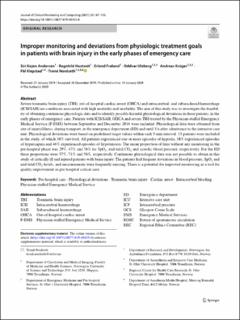| dc.description.abstract | Severe traumatic brain injury (TBI), out-of-hospital cardiac arrest (OHCA) and intracerebral- and subarachnoid hemorrhage (ICH/SAH) are conditions associated with high mortality and morbidity. The aim of this study was to investigate the feasibility of obtaining continuous physiologic data and to identify possible harmful physiological deviations in these patients, in the early phases of emergency care. Patients with ICH/SAH, OHCA and severe TBI treated by the Physician-staffed Emergency Medical Service (P-EMS) between September and December 2016 were included. Physiological data were obtained from site of injury/illness, during transport, in the emergency department (ED) and until 3 h after admittance to the intensive care unit. Physiological deviations were based on predefined target values within each 5-min interval. 13 patients were included in the study, of which 38% survived. All patients experienced one or more episodes of hypoxia, 38% experienced episodes of hypercapnia and 46% experienced episodes of hypotension. The mean proportion of time without any monitoring in the pre-hospital phase was 29%, 47% and 56% for SpO2, end-tidal CO2 and systolic blood pressure, respectively. For the ED these proportions were 57%, 71% and 56%, respectively. Continuous physiological data was not possible to obtain in this study of critically ill and injured patients with brain injury. The patients had frequent deviations in blood pressure, SpO2 and end tidal CO2-levels, and measurements were frequently missing. There is a potential for improved monitoring as a tool for quality improvement in pre-hospital critical care. | en_US |

